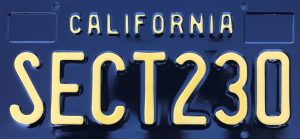Section 230 Preempts Two More Harassment Lawsuits
Recapping a couple of doomed-from-inception lawsuits.
Benedict v. Google LLC, 2024 WL 3427161 (D. Ariz. July 16, 2024)
Lance Benedict is a musician. Someone attacked him on the heavy metal website “All That Shreds” (apparently gone now), posting allegedly doctored images and defamatory statements. Those items got indexed in Google and appeared in Benedict’s vanity searches. Benedict complained to Google with predictable (non)results. He claims the false info ruined his career and marriage and led to other deleterious consequences.
Trademark. “A defendant does not “use” a plaintiff’s mark to [infringe] when the defendant merely provides a search engine service that allows third parties to search using the plaintiff’s mark. A defendant also does not “use” the mark under the Lanham Act if it merely produces search results that contain the plaintiff’s mark.”
Defamation. The defamation claim fails due to the statute of limitations. Apparently the publication took place in 2019 and he filed suit in 2023.
 Harassment. Section 230 applies. “Plaintiff failed to allege any facts that suggest Defendant did any more than passively display content created by third parties. Defendant thus is an interactive computer service provider in this context and has immunity from suit arising out from content created by third parties.” As you know, Section 230 applies even if defendants do more than passively display content.
Harassment. Section 230 applies. “Plaintiff failed to allege any facts that suggest Defendant did any more than passively display content created by third parties. Defendant thus is an interactive computer service provider in this context and has immunity from suit arising out from content created by third parties.” As you know, Section 230 applies even if defendants do more than passively display content.
Todino v. Twitter Inc., 2024 WL 3421685 (Mass. App. Ct. July 16, 2024)
“According to Todino’s amended complaints, anonymous users posted content to the social media sites that included false statements about him, or offensive material (such as pornography) that falsely was presented as having been posted by him…He claims that the identified defendants are liable in their own right for refusing to take down the posts even after he demonstrated their defamatory nature.”
This is an obvious Section 230 case. To get around it, Todino argued that he was suing for failure to remove the postings. (I can’t confirm that Todino was pro se, but this argument is a good signal of pro se status). That tired argument fails again. The court cites the old Lycos case for the proposition that 230 applies to failure to remove, even after notice. The court adds “Recasting the defamation claim as one for negligence does nothing to save it from falling within § 230’s ambit.”
An easy dismissal, but with a weird final footnote:
Lest our ruling be misunderstood, one final clarification is warranted. If someone in Todino’s position had secured injunctive relief requiring third parties to remove defamatory content that they had posted to a social media site, but those parties refused to comply, the question would arise whether such a plaintiff could secure an order requiring the social media sites themselves to remove the material (on the theory that the plaintiff was not invoking their own liability but simply enforcing the judgment against the third party)…We do not reach this issue because it is not presented in the current appeal.
Say what? The court cites to Hassell v. Bird, but this issue is older, such as the old Blockowicz case (which was a federal case, while this is a state court case). Those cases stand for the proposition that plaintiffs can’t work around Section 230’s immunity for the intermediary by getting an injunction binding only the poster. So what is the court suggesting, and why did the court use the subjunctive voice? Did Todino say he was going to get an injunction against the initial posters? Was the court offering him free legal advice? The mind reels.
